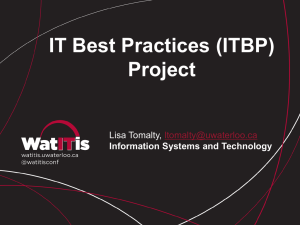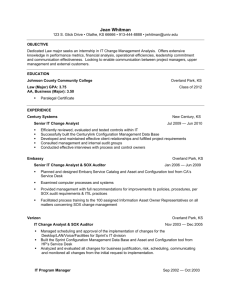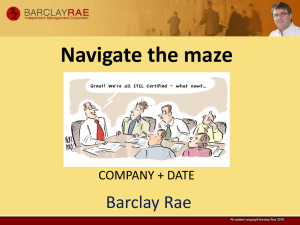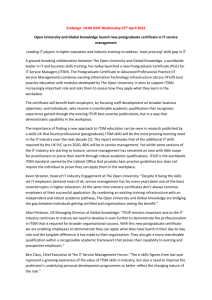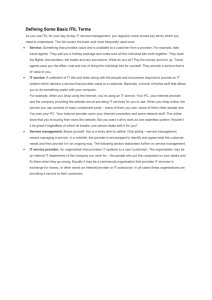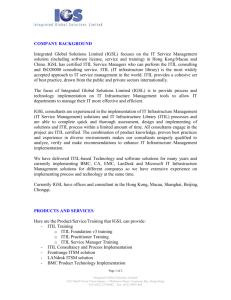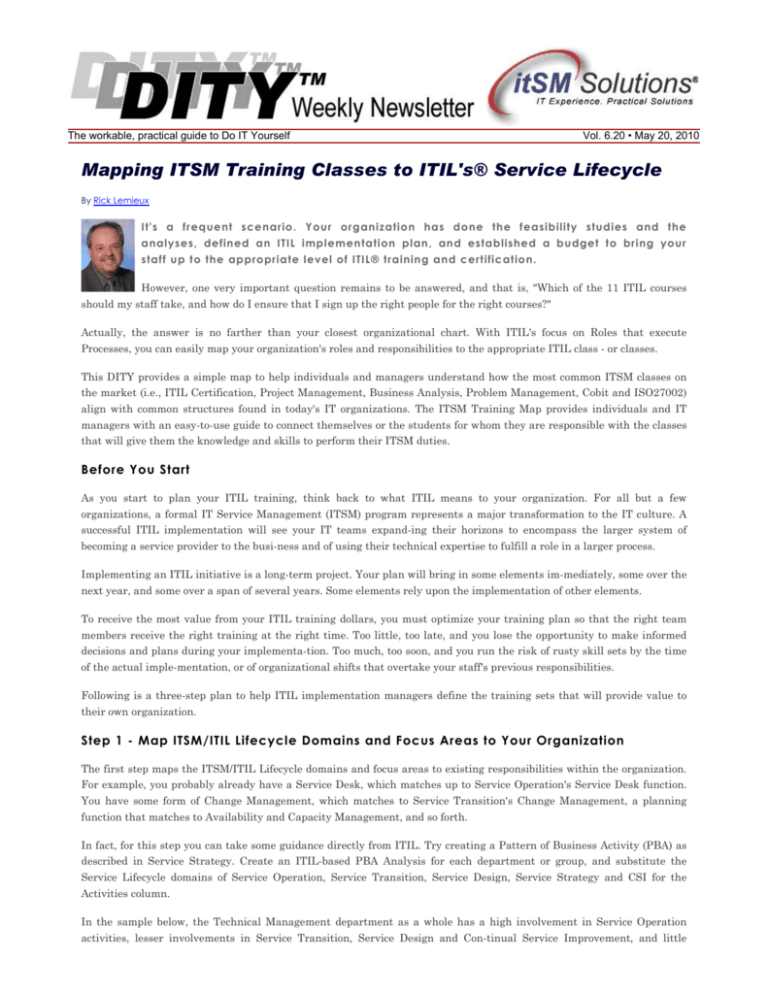
The workable, practical guide to Do IT Yourself
Vol. 6.20 • May 20, 2010
Mapping ITSM Training Classes to ITIL's® Service Lifecycle
By Rick Lemieux
It's a frequent scenario. Your organization has done the feasibility studies and the
analyses, defined an ITIL implementation plan, and established a budget to bring your
staff up to the appropriate level of ITIL® training and certification.
However, one very important question remains to be answered, and that is, "Which of the 11 ITIL courses
should my staff take, and how do I ensure that I sign up the right people for the right courses?"
Actually, the answer is no farther than your closest organizational chart. With ITIL's focus on Roles that execute
Processes, you can easily map your organization's roles and responsibilities to the appropriate ITIL class - or classes.
This DITY provides a simple map to help individuals and managers understand how the most common ITSM classes on
the market (i.e., ITIL Certification, Project Management, Business Analysis, Problem Management, Cobit and ISO27002)
align with common structures found in today's IT organizations. The ITSM Training Map provides individuals and IT
managers with an easy-to-use guide to connect themselves or the students for whom they are responsible with the classes
that will give them the knowledge and skills to perform their ITSM duties.
Before You Start
As you start to plan your ITIL training, think back to what ITIL means to your organization. For all but a few
organizations, a formal IT Service Management (ITSM) program represents a major transformation to the IT culture. A
successful ITIL implementation will see your IT teams expand-ing their horizons to encompass the larger system of
becoming a service provider to the busi-ness and of using their technical expertise to fulfill a role in a larger process.
Implementing an ITIL initiative is a long-term project. Your plan will bring in some elements im-mediately, some over the
next year, and some over a span of several years. Some elements rely upon the implementation of other elements.
To receive the most value from your ITIL training dollars, you must optimize your training plan so that the right team
members receive the right training at the right time. Too little, too late, and you lose the opportunity to make informed
decisions and plans during your implementa-tion. Too much, too soon, and you run the risk of rusty skill sets by the time
of the actual imple-mentation, or of organizational shifts that overtake your staff's previous responsibilities.
Following is a three-step plan to help ITIL implementation managers define the training sets that will provide value to
their own organization.
Step 1 - Map ITSM/ITIL Lifecycle Domains and Focus Areas to Your Organization
The first step maps the ITSM/ITIL Lifecycle domains and focus areas to existing responsibilities within the organization.
For example, you probably already have a Service Desk, which matches up to Service Operation's Service Desk function.
You have some form of Change Management, which matches to Service Transition's Change Management, a planning
function that matches to Availability and Capacity Management, and so forth.
In fact, for this step you can take some guidance directly from ITIL. Try creating a Pattern of Business Activity (PBA) as
described in Service Strategy. Create an ITIL-based PBA Analysis for each department or group, and substitute the
Service Lifecycle domains of Service Operation, Service Transition, Service Design, Service Strategy and CSI for the
Activities column.
In the sample below, the Technical Management department as a whole has a high involvement in Service Operation
activities, lesser involvements in Service Transition, Service Design and Con-tinual Service Improvement, and little
involvement in Service Strategy.
Sample ITIL PBA Analysis - Technical Management department, Company XYZ
Hi
3
3
1 Low N/A
Service Operation
Service Transition
Service Design
Service Strategy
Continual Service Improvement
Now you know the level of involvement of each of your groups in each domain!
Step 2 - Map Staff Roles to ITSM/ITIL Training Programs
Training and certifying in the ITIL is one of the keys to success for any ITSM program. Training programs include ITSM
Practitioner and ITSM Leadership tracks, which align closely to ITIL V3's Capability and Lifecycle courses. The chart
below depicts the relationships of IT Service Management course tracks to the major components of an organizational
structure.
Again, following the guidance in Service Strategy, create a User Profile for each job position, defining the ITIL roles and
process responsibilities for each title. Finish your exercise by matching the User Profile to the ITIL PBA Analysis to
identify the Leadership, Practitioner and Over-sight/Guidance role(s) each position fills within each Lifecycle domain.
For example, your Technical Services group may spend the majority of their time performing strictly operational
activities, such as defined in the Operational Support & Analysis (OSA) pro-gram. However, they may also be involved in
Service Design when planning a new service, or in Service Transition when releasing a new service into production. The
chart below is a simplistic rendition of matching User Profiles in the Technical Management function to Patterns of
Business Activity with "ITIL" substituted for "Business."
Sample User Profiles - Technical Management department, Company XYZ
User Profile (Job Title)
Manager
Supervisor - Network
Services
Senior Network Analyst
Network Analyst
Patterns of Business (ITIL) Activity
Service Operation - Manage daily Technical Operation activities, serve as Problem Manager on a rotating basis
Service Transition - Manage technical transition activities, participates in Change Advisory Board (CAB)
Service Design - Participate in Service Design reviews
Service Operation - Plan daily activities, supervise staff, participate in Problem Management activities
Service Transition - Plan technical transition activities, participate as requested in Change Impact Assessments
Service Design - Participate as requested in Service Design reviews
Service Operation - Perform daily activities, participate in Problem Management diagnostic activities
Service Transition - Lead technical transition groups during transition activities, participate as requested in Change
Impact Assessments
Service Design - Participate as requested in Service Design reviews
Service Operation - Perform daily activities, participate in Problem Management activities as requested
Service Transition - Participate in transition activities
Service Design - Limited participation
Step 3 - Reinforce ITIL with Complementary Training Programs
Do not limit your ITSM training plan to just ITIL courses. ITSM training involves not only the certification classes
outlined in the ITIL but also a series of complementary courses that provide knowledge and skills for other best practice
frameworks that tie into your ITSM program.
Examples of some of the complementary ITIL training areas include IT Business Analysis, IT Project Management and IT
Problem (i.e., troubleshooting and critical thinking) Management programs.
Summary
Hopefully the above information has provided some insight into how the various ITSM training programs can map to your
own IT organizational structure. Feel free to download the ITSM Training Map mentioned above to assist you in planning
your ITSM training program.
Entire Contents © 2010 itSM Solutions® LLC. All Rights Reserved.
ITIL® is a Registered Trade Mark of the Office of Government Commerce in the United Kingdom and other countries.


